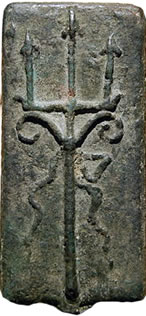Coins of ancient Rome

The first coinage of the Rome history, according to legend, was desired by King Numa Pompilius and the currency was called nummo by its name; in reality at the time of King Numa trade was still mostly bartering, the coins began to be used when intensified exchanges with other peoples also for the work of the merchants who sailed up the Tiber.
It seems that the first coin was minted in 573 BC during the reign of Servius Tullius and it was a piece of bronze and you could be depicted or an ox or a sheep, domestic animals subject of frequent exchanges in each market. Just by domestic animals, such pecus comes the archaic name of the coins: pecunia.
These first coins were not round but it was the rough bronze pieces and are marked now with the name of Aes Rude bars without graphics and with the name of Aes Signatum bars on which were engraved design or inscriptions; the first Roman Aes signatum dates from the fifth century. B.C. and it has the inscription "Romanom", that of the Romans.
From the encounter with other peoples also arose the need to adjust the form and so you went to the rounded shape of the coins already used from the fifth century BC in Greece and among the peoples of Magnagrecia and the Etruscans; Thus was born the Aes Grave, which presented the figures and / or markings on both the forehand and on the backhand.
The Aes Grave weighed 1 pound, well 272 grams, and often it was also used in the mergers of other objects, at least until its face value did not exceed the real one. The first Roman coinage was based so on Axis that had both sub mutliple that mulpiple, one of these was the bronze dupondius who weighed less than 2 pounds but there was also the bronze decussis that weighed 10 pounds; these were coins to deposit more than to use in everyday exchanges.
The Roman Republic was forced to use these coins difficult to handle because it had little silver and a little gold; with the first conquests Rome could have precious metals and coins became "light"; with the reduction of the weight of these coins they were never merged but beaten.
There are also the golden quinarius and silver quinarius that were half worth of that aureus and the denarius, respectively.
This coins were the money that was used throughout the Roman Empire and it was up to the reform of Diocletian beginning of the fourth century. A.D., although with progressive changes in the value and title of the metals; the first change was decided by Nero with a aureus devaluation of 11% and the denarius devaluation of 12.5%. Domitian returned the values to those established by Augustus, but the economic situation in the empire had changed and so Trajan reintroduced the amendments made by Nero.
In 215 A.D. Caracalla thought to change the value and the title of the coins: the aureus now weighed 6.54 grams against 7.78 grams at the time of Augustus and also the denarius had lost half its value; this large devaluation led Caracalla to introduce two coins that were worth exactly twice the reference currencies, namely the binione or double aureus and double denarius known as antoninianus.
By comparing the Roman Empire coin to the values today can be considered the value of an axis of around 50 euro cents.
by M.L. ©ALL RIGHTS RESERVED (Ed 1.0 - 25/07/2016)






